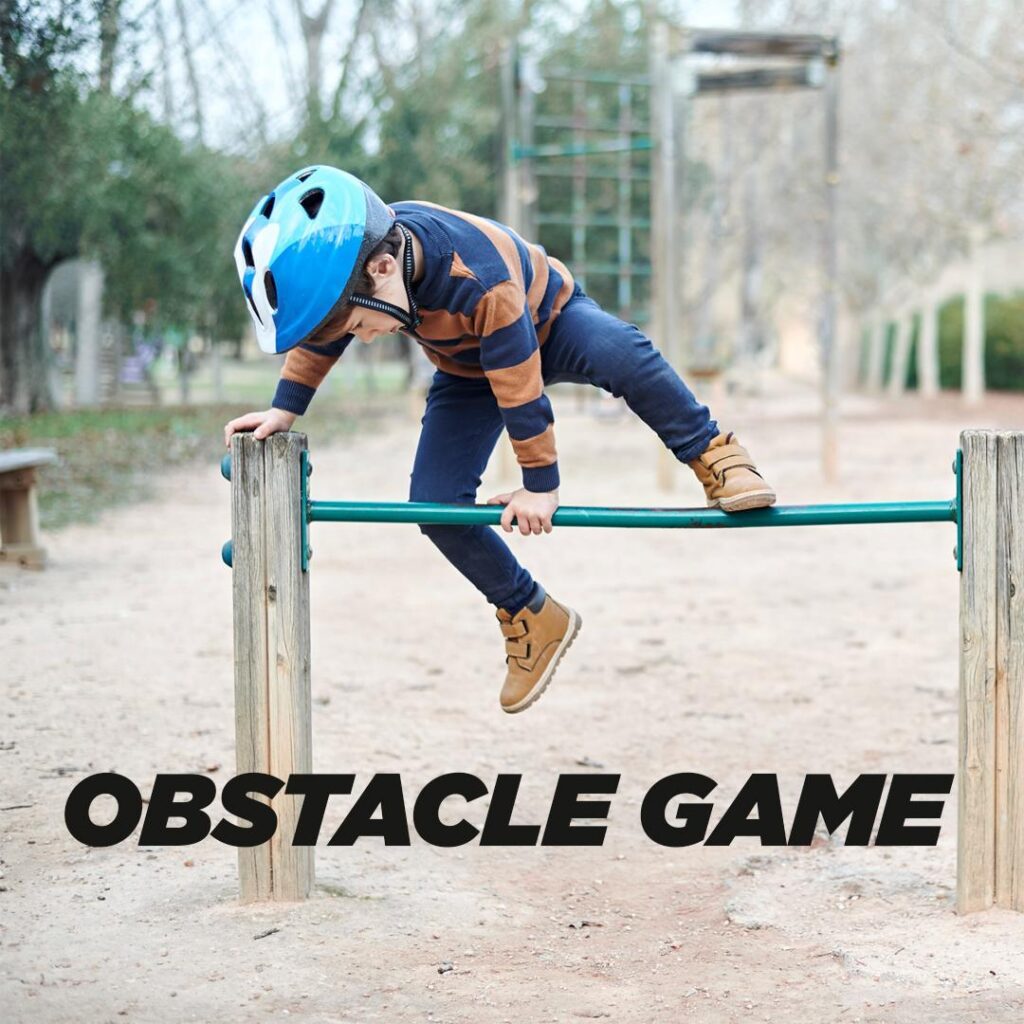If you’ve struggled to pull your children away from mobile devices & gaming screens or noticed that their energy is being channelled in the wrong direction, don’t worry—we’ve got you covered! The solution? A fun and creative obstacle game designed not only to engage your children physically but also to help them develop valuable skills. By adding a trampoline to the mix, you’re giving them the chance to jump, laugh, and challenge themselves through various obstacles—transforming learning into play.
In today’s world, where children are often engrossed in video games and esports, physical activity can easily be overlooked. They miss out on the joy of outdoor fun, learning new skills, and interacting with friends face-to-face instead of through chat boxes or social media.

That’s where our obstacle game comes in! With a trampoline as the centrepiece and simple household items turned into exciting challenges, this game is perfect for parents and teachers looking to encourage active play without forcing it. Ready to set it up? Let’s go step by step through everything you’ll need and how to create a course that’ll keep the children moving and laughing for hours!
Obstacle Games Play an Important Role in Child Development
Obstacle games, especially those involving family trampoline, are not just about fun; they play a critical role in helping children develop essential skills. Here’s how obstacle games can positively impact your child’s growth, while also addressing some challenges parents and teachers face today.
- Physical Development: In a world where children often spend more time in front of screens than outside, physical activity can become neglected. Obstacle games offer a simple solution. By jumping on high quality trampolines, dodging pool noodles, or hopping through hula hoops, children engage their gross motor skills. These activities improve coordination, balance, and agility—all of which are key to healthy physical development. Instead of forcing them to exercise, obstacle games move a natural and exciting part of play.
- Cognitive Development: Getting children to think creatively and solve problems can be a challenge, especially in structured environments. However, obstacle games stimulate their minds as well as their bodies. Navigating different challenges in the course requires quick thinking and creativity.
- Teamwork and Social Interaction: One common struggle for parents and teachers is helping children improve their social skills, especially when they are more inclined to interact through screens rather than face-to-face. Obstacle games naturally promote teamwork and cooperation. Whether they’re helping each other through tricky sections of the course or simply cheering each other on, children learn the importance of communication and collaboration. This builds social bonds and helps them understand the value of working together.
- Confidence Building: In today’s fast-paced world, boosting a child’s self-confidence can be difficult, especially when they’re constantly comparing themselves to others. Obstacle games provide a healthy environment for children to face challenges head-on and experience small victories. Each stage they conquer in the course reinforces their self-esteem and resilience.
By integrating fun and physical activity with cognitive, social, and emotional growth, obstacle games provide a well-rounded developmental experience for children. Up next, let’s get into the exciting part: what you need to set up the perfect obstacle game!
Items Required for the Obstacle Game
Ready to set up the perfect obstacle game? With just a few simple household items, you can create an exciting course that’s not only fun but also helps children develop essential skills.
- Pool Noodles: Pool noodles aren’t just for swimming! These flexible foam tubes are great for creating tunnels or barriers that children can crawl through or jump over. If your child tends to get bored with repetitive activities, using pool noodles in different ways keeps the game fresh and engaging.
- Trampoline: The inground trampoline is the heart of this obstacle game. It’s where children can jump, practice balance, and enjoy a burst of energy between other challenges. For parents struggling to get their children to engage in physical activity, a trampoline provides an irresistible fun factor that also boosts coordination and agility.
- Hula Hoops: Hula hoops are incredibly versatile. They can be used for jumping through, hopping in and out, or even rolling across the ground as part of a race. If your child is hesitant about trying new challenges, starting with something familiar like a hula hoop makes them more willing to participate in the game.
- Rolled-Up Towels: Who knew towels could be so useful? Rolled-up towels make perfect stepping stones or low hurdles. Childrens can practise their balance by walking across them or challenging themselves to hop over them without touching.
- Large Pillow: A large pillow serves as a soft landing zone or a balance challenge. Whether your child is hopping off the sport trampoline or tiptoeing across the pillow, it adds an extra layer of excitement and variety to the course. For parents concerned about safety, pillows create a soft and cushioned surface.
- Fruit/Veggie Cards: Why not add an educational twist? Scatter cards with pictures of fruits and vegetables throughout the obstacle course. Children can collect or match the cards as they complete each challenge.
Each item adds a unique challenge, turning everyday objects into tools for creativity and movement. Let’s start the transformation of your garden into a fun garden!
Ready, Steady, Let’s Play!
It’s time to transform your space into a fun, energetic, and developmental obstacle course! Follow these steps to create a game that’s not only exciting but also helps improve your child’s coordination, problem-solving, and fitness. Let’s jump in!
Step 1: Pool Noodle Tunnel
Start by laying pool noodles on the ground or propping them up as arches for the children to crawl under or hop over. This first challenge encourages children to use their agility and balance as they figure out how to manoeuvre through or around the noodles. If your child tends to get bored easily, this colourful and flexible obstacle will keep them engaged right from the start.
Step 2: Trampoline Jump Zone
Next up, place the rectangle trampoline as the second stage of the course. Ask the children to jump five times or perform specific tasks like balancing on one leg or touching their toes while in the air. The trampoline adds a burst of fun and helps improve core strength, balance, and coordination. If you’ve struggled to get your child to enjoy physical activities, the trampoline will be their favourite part!
Step 3: Hula Hoop Leap
Position the hula hoops on the ground or hold them up as jumping targets. Children can leap through the hoops or aim to land perfectly inside them. This step helps them practise precision and spatial awareness, which are essential for developing coordination. If your child finds it challenging to judge distance, the hula hoops provide a fun way to work on those skills.
Step 4: Towel Stepping Stones
Roll up towels and scatter them across the floor, creating “stepping stones” that children must walk or hop across without “falling into the lava” (touching the floor). This obstacle challenges children to focus on their movements and maintain balance. For parents whose children struggle with coordination, this is a great way to improve those skills in a playful environment.
Step 5: Large Pillow Balance
Place a large pillow on the ground as a balance challenge. Have the children walk across it or try to balance on one foot for a few seconds. The soft surface provides a safe way to improve stability and core control. If you’re worried about falls or injuries, the pillow ensures a cushioned and safe experience while still providing a challenge.
Step 6: Fruit/Veggie Card Collection
For the final challenge, scatter fruit and veggie cards throughout the obstacle course. Children must collect the cards while navigating the obstacles, encouraging them to think and match the cards as they move. This adds an educational twist, making it a great solution for parents who want to combine learning with playtime.
With each stage providing its unique challenge, this obstacle game offers a blend of fun, fitness, and development. Ready to see your children jump, balance, and learn their way through this exciting course? Let the games begin! But wait! Without ensuring safety, your fun course could pose a risk to your children. Let’s make sure to implement some safety measures.
Safety Precautions for a Fun and Secure Obstacle Game
Before starting the obstacle game, safety should always come first. We all want our children to have fun, but it’s essential to ensure they stay safe while playing. With trampolines and other obstacles involved, following some basic safety precautions can prevent accidents and keep the experience enjoyable for everyone.
1. Clear the Ground: Start by making sure the play area is free of any sharp objects, debris, or clutter. Even a small rock or toy left on the ground can lead to trips or falls. Take a few moments to clear the ground, ensuring a smooth and safe space for the game.
2. Set Up the Trampoline Properly: Double-check that your trampoline is set up according to the manufacturer’s guidelines. Ensure it’s stable, the springs are intact, and the jumping mat is in good condition. Don’t skip this step—it can make all the difference in preventing accidents.
3. Use a Safety Net: Install a safety net around the trampoline to avoid any unexpected falls. Children can get carried away while jumping, and the last thing you want is for them to bounce out of control. A safety net provides an added layer of security, so even if they lose their balance mid-air, they stay safely contained within the trampoline.
4. Use Trampoline Ladders: Make sure a trampoline ladder is in place to help children get on and off safely. A ladder ensures that children have safe access and exit points, reducing the risk of mishaps. Especially for younger children, this small addition can be a big help in keeping them safe.
By following these safety precautions, you can rest assured that your obstacle game is not only fun but also secure for your children. Let’s make safety a priority while keeping the play full of energy and excitement!
Conclusion:
With just a trampoline, pool noodles, hula hoops, and a little creativity, you can transform ordinary playtime into an exciting obstacle course that fuels both fun and development. By setting up these simple challenges, you’re giving your children the opportunity to learn essential skills like coordination, problem-solving, and teamwork—all while keeping them active.
Obstacle Game: The Fun Fix for Screen-Time Struggles!!!
To keep the game fresh and exciting, mix up the obstacles regularly. Children can quickly lose interest when activities become repetitive, but with new twists, they’ll stay engaged and motivated. Whether it’s jumping through hula hoops or balancing on pillows, the variety will challenge them in different ways, promoting both physical and mental growth.
So, are you ready to turn your garden into an adventure zone? Gather your supplies, set up your trampoline obstacle course, and watch your children thrive! Don’t forget to share your creative setups and experiences—you might just inspire other parents and teachers to join in the fun!
Engage kids in outdoor games like obstacle courses, sports, or creative crafts that stimulate their minds and bodies.
Set clear limits, offer fun alternatives like a trampoline obstacle game, and create tech-free zones at home.
Excessive screen time can lead to sleep problems, reduced physical activity, and behavioural issues.
Check if the settings are configured correctly or if your child has found a way to bypass them.
Too much screen time can worsen attention and behavioral issues in children with ADHD.





